How whales help ocean ecosystems, the climate and mankind
Discover how whales help to remove carbon dioxide from the atmosphere, create oxygen and fertilise phytoplankton upon which all sea life depends.
Introduction
Scientific research increasingly confirms the vital contributions of whales to the oceans, the planet and mankind. Whales are at the heart of the food chain that supports ocean life helping fish and many other species to thrive and reproduce. Whales also help to stabilise the Earth's atmosphere in the removal of carbon dioxide and the generation of oxygen.
Climate change is having a tremendous impact on the Earth, so much so that carbon dioxide in the atmosphere has now hit the highest levels in human history. Whales play a crucial part in helping the oceans, and man, fight climate change.
Whales desperately need to be conserved and their numbers restored to help man rehabilitate the oceans and atmosphere. Yet, whales are dying in greater numbers than ever before due to climate change, ocean warming, ocean acidification, plastic pollution, chemical pollution, sea dumped munitions, noise pollution,
ship strikes, entanglement and bycatch, Illegal, unregulated and unreported fishing - and needless, illegal whaling by Japan, Norway and Iceland
Whales have a big impact on the whole planet
The whale family includes the largest animals ever to have existed on earth. The largest is the blue whale measuring 30 metres (100 feet) in length and 180 tonnes. The bowhead whale can live 200 years, or longer. Gray whales make the longest migration travelling between 16,000–20,000 km (10,000–12,400 miles) every year.
Because of their size, long life span and distances travelled, whales have a significant impact on the whole planet. Whales are vital in maintaining the health and balance of ocean ecosystems and make a significant contribution to the Earth's environment that directly affects each and every one of us and future generations.
The vital contributions that whales make to the environment and mankind
Unlike man, whales are perfect custodians of their environment, giving back more than they consume whilst regulating and maintaining ocean ecosystems and the atmosphere above. The vitally important contributions of whales include:
- Replenishment of oxygen into the Earth's atmosphere.
- Prevention of global warming through the sequestration of atmospheric carbon dioxide.
- Fertilisation of global marine ecosystems.
- Food web regeneration enabling bigger fisheries and higher abundance.
- Regeneration of krill populations.
- Regeneration of plankton.
- Ocean food source for up to 50 years after the natural end of life.
- Restoration of ecosystems degraded by man.
Sea plants - The main source of oxygen
Whales have a symbiotic relationship with sea algae known as phytoplankton. Through photosynthesis, phytoplankton consume carbon dioxide from the atmosphere and release oxygen as a waste product. As land based creatures, we are well familiar with the plants around us that produce oxygen
such as grass and shrubs through to the Amazon rain forests. What is less obvious is that most of the oxygen that we breathe does not come from land plants, but from phytoplankton. This plant also consumes most of the carbon dioxide from the atmosphere.

Image credit: Steve Groom - Plymouth Marine Laboratory
Phytoplankton bloom from space
Enlarge
Earth comprises around 28% land, of which half is rock, desert and ice, so up to 14% is available for green plants. However, man is continually destroying the plants upon which we depend for life. Typically the continuing destruction of the rain forests of which 20% has been cut down so far.
The ocean occupies around 72% of the Earth's surface and all of this is available for the green oxygen producing plants, especially phytoplankton. Many sources estimate that between 50% and 85% of the world's oxygen is produced by phytoplankton although currently, an accepted value is more than 70%.
There are many thousand species of phytoplankton. When conditions are right, they flourish and their blooms can be seen from space and can last for several weeks. An individual phytoplankton however rarely lives for more than a few days. About 200 million tones of
phytoplankton grow in the world's oceans each year. That's about 10 times the weight of the entire human population.
Whales contribute toward more than half the air that we breathe
Whales play a vital role in providing the essential nutrient food source needed by phytoplankton. Phytoplankton form the base of the marine food chain and without it marine life cannot exist. All fish in the oceans depend on phytoplankton, whether directly or indirectly.
Phytoplankton produces most of the oxygen that we breath, more than trees and other land plants. Phytoplankton also removes most of the carbon dioxide from the atmosphere. Were it not for phytoplankton, man and many other creatures would not exist.
These miniscule single-celled plants live suspended within the ocean's sunlit photic zone which is illuminated to a depth of around 200 to 300 meters. Like land plants, phytoplankton consume carbon dioxide in sunlight to produce their needed food energy. Their waste product is an essential part of our life support system - oxygen.
Like land plants, phytoplankton cannot survive on carbon dioxide, water and sunlight alone, they need nutrients for photosynthesis, especially iron and nitrogen. The most critical nutrient for photosynthesis is iron, yet it is the rarest substance in the ocean having a background concentration of just 3 parts per trillion.
Whale poo, of all things, is especially rich in iron and nitrogen. Since whale faeces is fairly liquid and less dense than sea water, it floats to the surface as plumes where it is readily available to the phytoplankton and innumerable organisms that rely on their nutrient plumes for survival. Whales are the primary species that fertilise phytoplankton around the oceans during their long migration
routes, whilst sea currents and eddies distribute and mix the nutrients further.
The amount of oxygen produced by phytoplankton varies according to the season, climate, nutrient availability and other factors.
More than half the air that we breath comes from marine phytoplankton. Equally importantly, whilst phytoplankton create most of the oxygen that we breathe, dead and sinking phytoplankton remove most of the carbon dioxide from our atmosphere.
Each year, dead phytoplankton that fall to the deep ocean remove about 10 gigatonnes (billion tonnes) of carbon from the atmosphere
Phytoplankton therefore play a vital role in preventing global warming and have absorbed around a third of the carbon dioxide produced through our burning of fossil fuels.
Phytoplankton make up 98% of the ocean's food energy and are the foundation of virtually every marine food chain. Therefore, phytoplankton make most other ocean life possible.
Plankton are critical for human food security, the air that we breath, the removal of carbon dioxide from the atmosphere. Without plankton, all ocean life would end leading to a terrestrial mass extinction rivaling the loss of the dinosaurs.
Alarmingly, the Global Oceanic Environmental Survey (GOES) has reported that:
- Phytoplankton has been reducing by 1% each year over the last 20 years.
- Phytoplankton has reduced by more than 40% during the 50 years to 2012.
- Over the next 25 years, 75% of all plankton will be lost.
- Had we not killed 50% of plankton since the 1950's chemical revolution, we would not have had climate change.
Phytoplankton are also at the heart of the “biological carbon pump” which transfers about 10 gigatonnes of carbon from the atmosphere to the deep ocean each year. Even small changes in the growth of phytoplankton may affect atmospheric carbon dioxide concentrations, which would feed back to global surface temperatures.
The figure below illustrates the dependency of all sea life on phytoplankton.
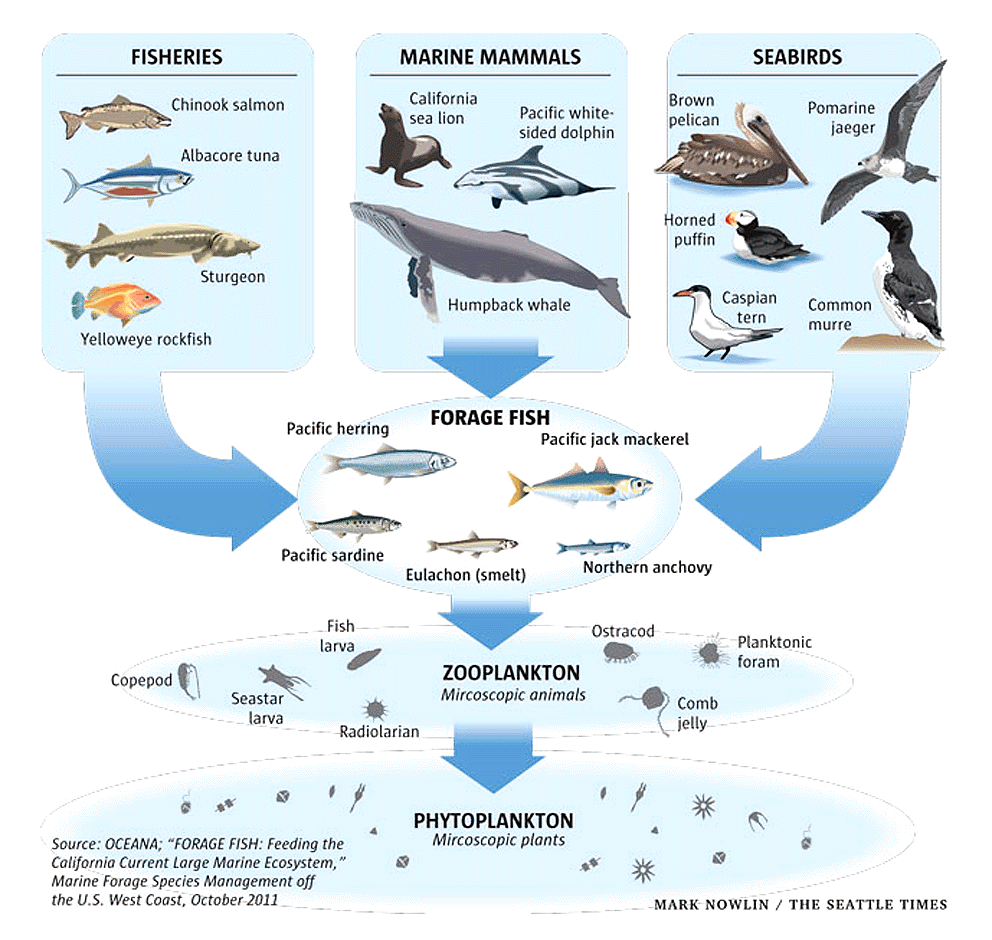
Dependency of fisheries, marine mammals and sea birds on phytoplankton
Whales fertilise the world's oceans
According to a paper, published in the British journal Proceedings of the Royal Society, Australian biologists have estimated that a pre-whaling population of 12,000 sperm whales in the Southern Ocean each defecate about 50 tonnes of iron into the sea every year. Sufficient to feed phytoplankton that
store 240,000 more tonnes of carbon in the deep ocean than the whales exhale. Southern Ocean sperm whales represent just
3 % of the global sperm whale population.
This study reveals that the baleen whales' faecal iron concentration is calculated to be about 10 million times that of Antarctic seawater," Before commercial whaling began early last century whales used to consume about 190 million tonnes of krill, converting this into about 7,600 tonnes of iron-rich
faeces. The research published in 2010, suggests that, in future, increasing populations of baleen whales and krill would have a positive effect on the productivity of the entire Southern Ocean ecosystem and could improve the ocean's ability to absorb CO2.
What is remarkable is the small number of links between phytoplankton, which provides the food for krill. which in turn is the foodstuff of baleen whales. To complete this cycle, whales provide the fertilizer to enable the phytoplankton to grow and flourish. By weight, krill are the heaviest animal species on Earth.
Research from 2015 revealed that the loss of faecal nutrients may continue to weaken ecosystem health, fisheries, and agriculture, leaving them less naturally productive than they might otherwise be. A 2016 report by ecologist Chris
Doughty of the University of Oxford and his colleagues estimated that the capacity of ocean animals to move nutrients around has decreased to just 5 percent of historic values.
The importance of whale faeces as a crucial source of micronutrients for plankton, has been recognised by the International Whaling Commission (IWC). This was part of a Draft Resolution on "Cetaceans and Their
Contribution to Ecosystem Functioning" that was adopted at the 2016 plenary of the IWC, with 36 governments voting yes, 16 voting no and 9 abstentions.

Krill
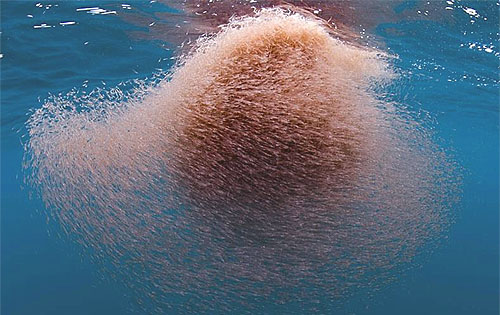
Swarm of Krill
New research has shown that krill numbers have fallen by 70% in just 40 years due to warming oceans. Also due to global warming, the oceans are becoming more acidic, which further threatens the long term survival of krill. This
report, has warned that climate change could reduce krill size by up to 40% in some areas of Antarctica’s Scotia Sea. increasing demand for krill by humans will further reduce fish stocks. Less krill = less food for other fish, less food for people, less food for baleen whales, less fertilisation
of the phytoplankton krill food.
Krill are also important in removing carbon dioxide from the atmosphere. After feeding from phytoplankton, krill move downward to produce carbon rich faecal pellets that sink to the depths removing carbon from circulation. A paper, published in December 2017, shows that krill could sequester
23 million tonnes of carbon to the deep sea each year, equivalent to annual UK residential greenhouse gas emissions.
High densities of whales result in bigger fisheries and higher abundance
A paper published in 2014 entitled "Whales maintained a high abundance of krill; both are ecosystem engineers in the Southern Ocean" shows that killing whales reduces, not increases, the abundance of krill. After 2,000,000 whales were killed between 1915 and 1970, contrary to expectations, there has been a substantial decline in the abundance
of krill.
A paper published in 2010 entitled "Iron defecation by sperm whales stimulates carbon export in the Southern Ocean", refers to the "krill paradox", which states that after removal of their baleen whale predators during commercial whaling, krill numbers decreased.
Removal of baleen whales may have led to a deficit of bioavailable nutrients at the base of the food chain, causing krill populations to decline. While the overall nutrient contribution of whales may be moderate on a global scale, these nutrients are not added arbitrarily across the ocean but rather are concentrated in the most productive areas, where high background levels of phytoplankton exist
that can quickly use such nutrient pulses.
A paper published in 2010 revealed that whales carry nutrients such as nitrogen from the sea depths where they feed back to the surface via their faeces and this process became known as a 'whale pump'. This productive rejuvenating cycle is similar to the already known 'biological pump', whereby microbes,
plankton, and fish recycle nutrients in ocean waters. However, whales and other marine mammals had largely been ignored in this cycle. The study shows that whales historically played a central role in the productivity of ocean ecosystems - and continue to do so despite diminished populations.
The paper adds that whales increase primary productivity resulting in "bigger fisheries and higher abundances throughout regions where whales occur in high densities,"
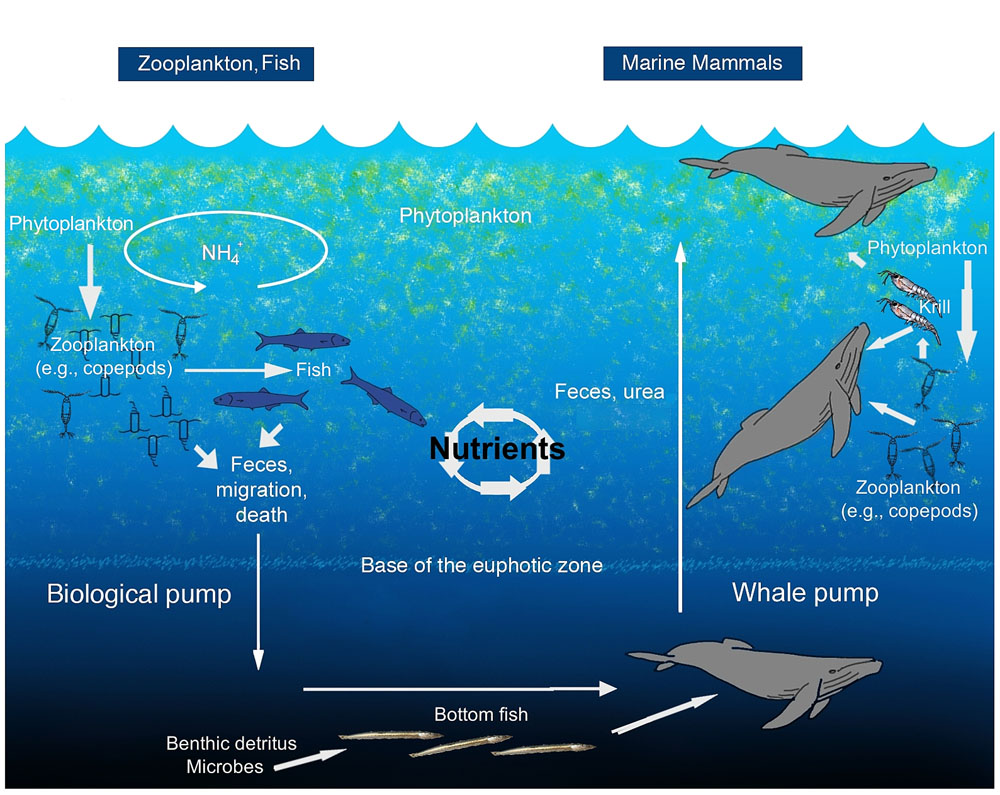
Nutrient Recycling Pumps
Whales fertilise the food base for all major marine ecosystems
Using the sun’s energy, carbon dioxide and whale fertiliser, phytoplankton multiply rapidly, forming the base of all major marine ecosystems, feeding countless marine larvae, copepods, krill, shrimps, mussels, clams, scallops, anchovies and other grazing fish.
The southern ocean is rich in nitrogen but poor in iron without which phytoplankton cannot reproduce and grow. Whale fertiliser provide the needed iron to support the phytoplankton growth upon which krill and fish depend. The presence of whales is an integral part of this cycle. Researchers have found that when baleen whales are killed, the amount of krill in southern ocean area declines, which
then affects the entire food chain. As study published in 2010 shows that If whale populations are allowed to recover in the Southern Ocean, greater productivity of phytoplankton will result as larger amounts of iron are recycled through
the system.
Whales help to remove millions of tonnes of carbon every year
As whale numbers dwindle, it could lead to increased greenhouse gases in the atmosphere. Whales help to sequester, or remove millions of tonnes of carbon dioxide from the Earth's atmosphere in three ways:
- Aiding phytoplankton bloom,
- Accumulating and storing carbon throughout their lives.
- Depositing carbon on the sea floor when they die naturally.
When whales swim from the sea depths to the surface, they bring with them nutrients from which phytoplankton feed. In addition, whale faecal fertilisation promotes plankton growth.
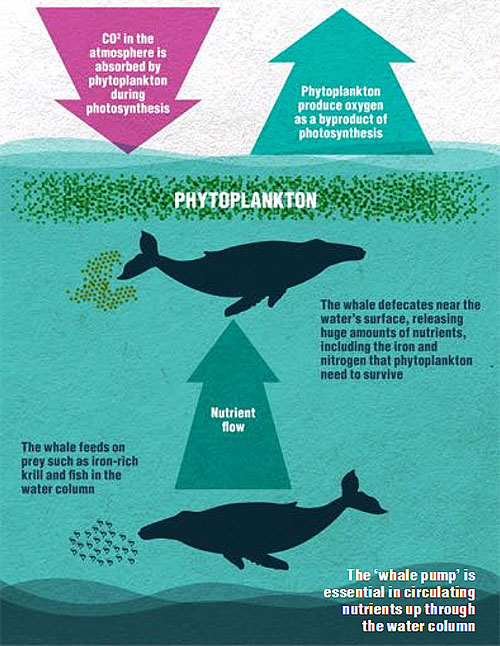
Synergetic benefits of whales to the
ocean and human environment
Phytoplankton play a critical role in regulating today's carbon cycles and removed about one third of the human-released carbon dioxide from the atmosphere. When the phytoplankton cells die, they sink from the surface taking the carbon with them and transfer it to the sea floor where it remains for thousands of years.
Through faecal fertilisation alone, whales remove 400,000 tonnes of carbon dioxide each year, twice as much as the 200,000 tonnes of carbon dioxide they exhale through respiration.
In addition to supporting phytoplankton, whales directly remove carbon throughout their long lives. Organic carbon from ocean food chains is readily absorbed by a whale who consequently becomes a large storage unit. A blue whale has a biomass of 90 tons and stores 9 tons of carbon within its tissues.
For the reasons mentioned above, whaling has a major detrimental impact on the human environment. A century of whaling equates to the burning of more than 70 million acres of forest. By killing a whale, the carbon stored in its body is released back into the atmosphere. But when the whale dies naturally, its carcass takes all of the stored carbon down to the ocean floor where it can
never be released again. A further loss of both present and future carbon removal is created when a whale with calf or pregnant whale is taken.
An informative paper published in 2010 entitled "The Impact of Whaling on the Ocean Carbon Cycle", includes the following findings:
- Populations of large baleen whales now store 9,100,000 tons less carbon than before whaling.
- Restoring all whale populations would remove 160,000 tons of carbon from the atmosphere each year through sinking whale carcasses alone. Equivalent to 110,000 hectares of forest.
- Whaling has reduced the populations of blue whales in the southern ocean by 99%.
- If restored to pre-industrial levels, southern hemisphere blue whales would remove 70,000 tons of carbon per year through sinking carcasses alone.
- Whaling is estimated to have released 23,500,000 tons of carbon into the atmosphere.
A further paper published in 2010 entitled "Iron defecation by sperm whales stimulates carbon export in the Southern Ocean", shows that the reduction in sperm whale numbers owing to whaling has resulted in an extra 2,000,000 tonnes of carbon remaining in the atmosphere every year.
A recent study published in February 2019, shows that climate change will reverse the recovery of whales in the Southern Ocean by damaging the krill on which they feed. Models predict concerning declines, and even local extinctions by 2100, for Pacific populations of blue and fin whales, and Atlantic and
Indian Ocean fin and humpback whales.
Graphs showing the increase in atmospheric carbon dioxide relative to population growth will be found here.
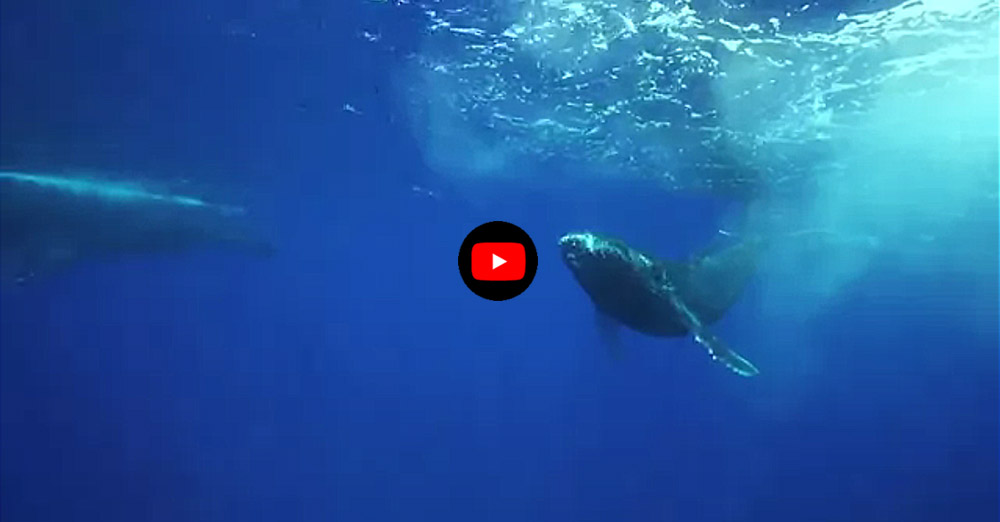
Video by Chris Bryan and Maggillivray Freeman, narrated by George Monbiot
How whales sustain ocean ecosystem health and help man in combatting changing climate.
Even when they die, whales keep giving
When whales die, they sink to the ocean floor and take with them all of the carbon their bodies have stored over their lifetime. For an average 40 ton whale carcass, this represents about 2000 kg (4409 lbs) of carbon dioxide.
A 2010 study calculated that the global pre-whaling population of approximately 2.5 million great whales would have exported nearly 210,000 tons of carbon per year to the deep sea through Deadfall Carbon. That’s equivalent to taking roughly 150,000 cars off the road each year. Unfortunately,
this ecosystem benefit has been lost due to whaling which has killed over 3 million whales since before the 1900's.
A whale fall provides food and shelter to some 400 species of sea life for up to 50 years. The whale provides food for scavenger organisms who decompose the carcass into nutrients for other organisms. For this reason too, every whale taken through whaling causes a substantial loss of deep-sea habitat and nutrients that further prevents fish stock replenishment.
The International Whaling Commission
The global protection and conservation of whales has been entrusted to the International Whaling Commission (IWC).
In 1978, Luis Kutner of the University of Miami Law School published a paper entitled: The Genocide of Whales: A Crime Against Humanity. Today, 40 years later, the scientific evidence increasingly shows that whaling is a crime against humanity and a crime against the environment.
As Luis Kutner adds: "The history of whaling is a story of slaughter", "The International Whaling Commission has had a dismal record in regulating whaling and the future does not look bright" Importantly, his paper proposes an alternative approach outside of the IWC. Whatever approach is adopted, for the benefit of the planet and life as we know it, whales need to be conserved and
protected, not needlessly slaughtered.
In 2016, the International Whaling Commission passed a groundbreaking resolution recognising the ecological role of whales and the significant contributions whales make to the environment and man. The workshop report, entitled "Role of Cetaceans in Ecosystem Functioning: Defining Marine Conservation Policies in the 21st Century",
can be found here.
The Impact of man on whale stocks
You only have to check the latest news to see that whales are increasingly dying every day.
Our section on Environmental Concerns explains the various ways how man is harming and killing whales and all other sea life. It also provides the latest evidence on how climate change will reverse the recovery of whales in the southern ocean.
Whales help to sustain ocean ecosystems and fish stocks whilst helping man in the fight against climate change. They also help to rehabilitate the increasing damage done by man to ocean ecosystems. Just recently, there was an international endorsement of "Whale Carbon" and whale conservation is increasingly being recognised as a means of fighting climate change.
In defiance of the 1986 IWC regulations, in defiance of world opinion and in defiance of global efforts to restore ecosystems, environment and climate - whales and other cetaceans continue to be slaughtered by Japan, Norway and Iceland because there is no enforcement of the regulations.





















